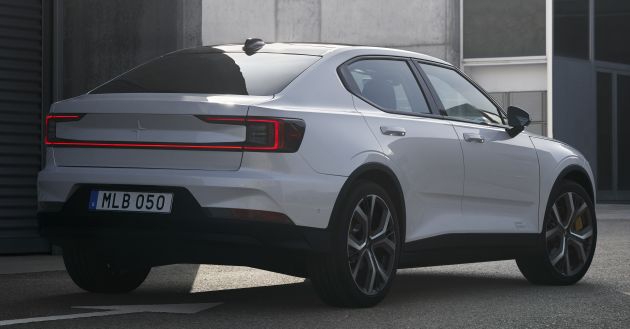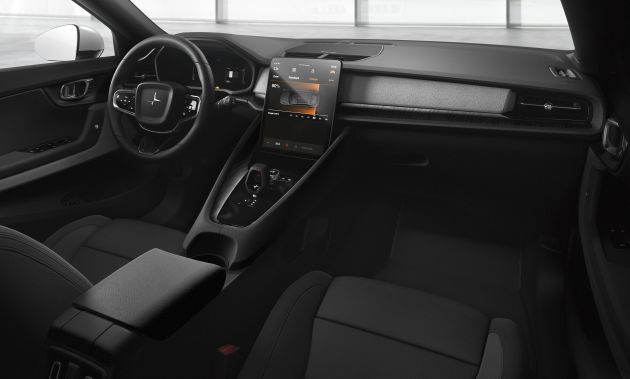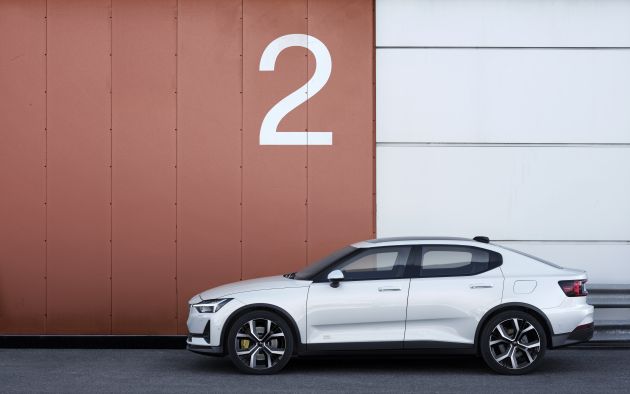Volvo’s electric vehicle upstart Polestar has big plans to disrupt the automotive industry, and at a glitzy Apple-style event at its Gothenburg headquarters, the company revealed its first fully-electric offering, the Polestar 2. This compact five-door notchback is looking to take on the Tesla Model 3 at its own game, with claims of similar range and performance figures.
As with the Polestar 1 coupé, the Polestar 2 is the production version of another Volvo concept, this time the 40.2 from 2016. It retains the show car’s compact proportions, sharp detailing and tall, almost SUV-like ride height, bolstered by the black body cladding.
The more abstract version of Volvo’s “Thor’s Hammer” headlights remain, equipped with new Pixel LED technology that can turn off parts of the high beam to avoid dazzling other users. The lamps are connected to the slimmer six-point grille, while a distinctive bone-shaped air intake features underneath. The windscreen wraps around the A-pillars to meet the side windows, ending at the C-shaped C-pillar.
Unlike a number of other carmakers (and, indeed, the 40.2 itself), Polestar has resisted the urge to switch to side-view cameras, instead persisting with traditional door mirrors. The company has reworked the design a little, making them frameless and using the entire housing for mirror adjustment rather than just the glass within, reducing the size by 30% and providing not just a sleeker look but also better aerodynamics.
At the rear, you’ll find C-shaped tail lights joined by a full-width light strip – these are made out of 280 LEDs that create a unique welcoming sequence as you approach the car. Speaking of which, you unlock your car not with a key but your smartphone – the Polestar 2 uses Bluetooth to recognise your phone within 1.5 metres of the car, and it unlocks as soon as you pull the door handle.
Enlarged graphics on the instrument display mean you’ll be able to easily see the charging status and range from the outside. Again, you won’t have to use a key to start the car, as there are sensors in the driver’s seat to detect if you’re sitting down – so it will be ready to go as soon as you get in, just like in a Tesla.
The interior is dominated by a massive 11-inch portrait-format touchscreen, which is linked to a new Android-based infotainment system. Developed in collaboration with Google, it features built-in Google Assistant voice control, Google Maps navigation (complete with charging station locations) and even the Google Play Store for apps. The centre console, topped by a tiny “gearlever”, is taller than in other Polestar and Volvo models.
Polestar says that the 2 will feature a vegan interior as standard, dispensing with the use of leather. Available options include fabric and a new Weave Tech material that the company says is inspired by diving wetsuits and is water and dirt resistant, although you can also pick perforated Nappa leather if you so wish. There are also a number of trim options such as a 3D-etched polycarbonate and black ash wood.
Details on model variants have yet to be revealed, but Polestar has listed initial technical specifications of the range-topping version with the most power and range. A pair of electric motors, each producing 150 kW (204 hp) and 330 Nm of torque, are placed on each axle to provide all-wheel drive – do the math and you’ll get to the total system output of 300 kW (408 hp) and 660 Nm.
That’s around the same amount of power as Volvo’s T8 Twin Engine plug-in hybrids but with an additional 20 Nm, allowing the Polestar 2 to sprint from zero to 100 km/h in under five seconds. With a 78 kWh battery, Polestar targets a range of up to 500 km on the new, more stringent WLTP cycle.
The Polestar 2 is built on the same Compact Modular Architecture (CMA) platform as the Volvo XC40 and the Lynk & Co 01, 02 and 03, and the 27-module battery pack is integrated into the floor of the car, contributing to the rigidity of the chassis. It also reduces noise, vibration and harshness (NVH), with road noise claimed to be 3.7 dB lower compared to a conventional chassis.
Buyers can specify a Performance Pack that adds Öhlins dampers, Brembo brakes and 20-inch forged alloy wheels, plus gold accents including the seat belts, brake callipers and even the valve caps on the wheels. Pricing for the first 12 months will start at €39,900 (RM184,800), rising up to €59,900 (RM277,400) for the launch version with all the bells and whistles, and the car will also be available through subscription. Production will kick off in China in February next year.
Source: Read Full Article




